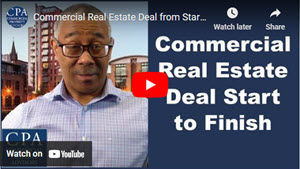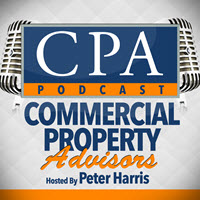What does financial freedom mean to you? It might mean leaving your job, reducing your workload, or simply having more freedom when making financial choices. But just how big does your commercial real estate portfolio need to be to break off the shackles of the daily grind? And how do you calculate that number? Over twenty years ago, my then mentor, Robert Kiyosaki, taught me what I now call the ABC’s of financial freedom.
A: Set a Goal (Calculate Your Number)
Your first step is to set a goal by calculating the minimum passive income you need to produce in order to leave your job. To leave my corporate job, I personally needed $4,200 a month to cover all my expenses. This included my mortgage, insurance, taxes, medical insurance, cell phone, utilities, food, and my son’s football expenses. It was the minimum I needed to leverage up. Your minimum passive income is the cost to live, without any extra unnecessary costs.
You also need to set an exit date goal. Then print out these goals and make it visible so that you can hold yourself accountable and put a little bit of pressure on yourself.
B: Make an Action Plan and Stick with It
Don’t stop working on this action plan until you achieve it. Stick with it! You must want it and be willing to put the work in to get this goal accomplished. There are no excuses because this is not an easy business. The most successful people in commercial real estate are the ones that are the most determined.
One tip Robert taught us was to avoid people that don’t believe in you. If you encounter negative people who say you can’t achieve your goals, you need to walk away from them. Don’t let them discourage you from executing your action plan.
C: Have the Right Mindset
Don’t listen to the negative voices in your head. Listening to these voices will cause you to lead a very average life. Most of my work with Robert Kiyosaki involved mindset. It focused on getting beyond limiting beliefs so you can discover and go after your true potential. Everyone has these limiting beliefs, these little voices that tell us that we cannot achieve our dreams. I have a blogpost called, The Right Mindset to Own Commercial Real Estate. If you read it, you will discover the mindset you need to successfully own commercial real estate.
The Missing Piece: Method
Those are the ABCs to financial freedom but there is still one key component that is missing: the method of how to accomplish the ABCs. Robert intentionally left this out of his teaching. Instead, he brought in experts who were already doing what we wanted to do. He brought in commercial real estate experts to teach, coach, and mentor us, which was a brilliant thing to do.
Commercial Property Advisors is a company that supplies the tools, methodologies, and strategies to get these deals done and help you achieve your goal of financial freedom. If you are a beginner investor or interested in commercial real estate investing, you can apply to our Protégé Program and get experienced mentorship.
How Big Does Your Portfolio Need to Be?
So, how many apartment units will it take to reach your goal of financial freedom? And how do you calculate that number? Well, let’s go over this example here so you can see how to calculate the number of units you need:
Property: 16-unit Apartment complex
Purchase Price: $1.3 million at 7% cap rate
Rents: $850/month
The annual income from rents on 16 units is $163,200. However, those units will not be occupied 100% of the time, so you subtract a vacancy rate of 5% from $163,200 to get a total annual income of $155,040.
Calculate the NOI: The annual income minus the expenses will determine your NOI. We will subtract 40% for operating expenses, these include taxes, insurance, repairs, property management, supplies, turnover, and any other operation expenses. This leaves us an NOI(Net Operating Income) of $93,024.
Calculate the Mortgage: The apartment building was purchased for $1.3 million with 25% down and a 4.5% interest rate amortized over 30 years, which gives a payment of $4,940 per a month. Multiplied over 12 months, your mortgage payment is $59,280 per a year.
Calculate the Annual Cashflow: Subtract the mortgage payment of $59, 280 from the NOI of $93, 024 which equals an annual cashflow of $33,744. This is a critical number because it is the total you will cashflow per a year on this 16-unit apartment building.
Calculate the Monthly Cashflow: When you divide your annual cashflow by 12, you come up with a total monthly cashflow of $2,812. Since we are trying to determine how much cashflow we need to produce per a unit, we then divide this number by 16 units and get a grand total of $175 per a unit.
In this general example, the property produces $175/month in cashflow per unit. Could I leave my job and go into commercial real estate investing full time with just this apartment complex? To find out divide the number you need by the amount per unit, and you will know how many units are needed to accomplish your goal. I needed $4,200/month, so $4,200 divided by $175 per unit equals 24 units. My example deal of 16 units will not be enough for me to reach my goal of financial freedom. I need a total of 24 units to break off the shackles of the daily grind.
Quick link: Watch my teaching Analyzing Commercial Real Estate Quickly and Easily to further understand these calculations.
How I Mastered the ABC’s of Financial Freedom
#1: I Printed Out copies of My Goal.
My goal was to achieve $4,200/month in passive income by a particular date. I printed out eight copies of my goal and this date. Then I put these copies in places I would be sure to see them regularly.
#2: I Made my Goal Visible to Everyone
This will help you hold yourself accountable, and everybody needs accountability. We can all set goals but what forces you to take responsibility and get these goals accomplished? I had mine visible to friends and family so I could share with them what I was doing. This helped me stay on the right path. If goals are not written down, they probably won’t get done.
Wherever I went, I was reminded of how badly I wanted to achieve this goal. I wanted so badly to not work for someone else, and to have true financial freedom. I slowly began to ween myself off my engineering job by working less and less each week. And you can do that if you can achieve a steady passive income.
#3: I Kept a Running Tally of Cashflow
I kept a tally on my refrigerator where I wrote my goal number. Then every time I closed a deal, I would subtract the cashflow from that deal until I reached my final goal. I ended up reaching my goal two months early because I stayed focused and was held accountable.




